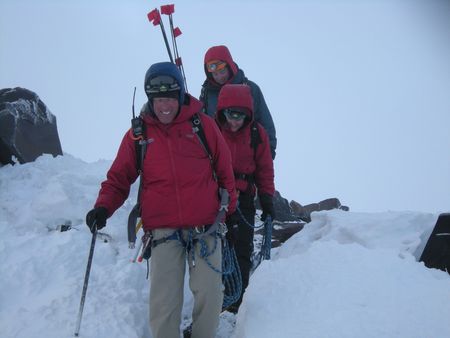
On July 31, , director of , became the first person to summit Mt. Rainier 500 times. He's since bumped that number up one, having just completed his 501st Rainier summit. He began guiding on the mountain in 1975 and has guided around the world, including the Alps and Machu Picchu. He regularly teaches ice climbing in Ouray, Colorado, in the winter and rock climbing in Joshua Tree, California, in the fall. Check him out, if you want to learn from a guru.
But before you go climbing, be prepared with the right gear. Here are Dunn's top ten climbing gear tips:
10. Buff: Get a or two, they are indispensable. I now carry two inmy pack. One to wear cowl style under my helmet and another to wear around myneck. A Buff is great protection for all types of weather, from blowing windand sleet to baking sun. It is lightweight, versatile and protective. I don鈥檛know how I ever did without this indispensible item! Plus, you can choose anynumber of color combinations, from camo to flash, to suit your personal style.
9. Glasses: I have a thing about glacier goggles with sideshields. Why would anyone want to purposely wear blinders? I much prefer agood close fitting pair of wrap-around glasses. My current favorite is the Reflex/Instinct. Invest in a good glasses case. A scratched pair of lensesreally limits your vision and reduces the protection of the lens coating.
8. Base layer: I want a primary layer that I can leave on from the startof climb to the drive home afterward. Lately I have been wearing the Sequence long-sleeve zip tee. It is a soft-feeling wool blend, driesquickly, has a long zip tee-neck for ventilation and doesn鈥檛 stink afterseveral days in the field. Hard to beat.
7. Insulation: I like all my insulation layers to have hoods.Hoods help trap body heat and keep you extra warm. I have been using two layersof synthetic lined jackets, one super-light and one warmer with a waterproofouter. I really like the Chaos jacket for the outer. It is warmer than itlooks and works supremely well in wet/stormy conditions. It is waterproof enoughthat I can often do away with a separate rain shell. These two insulatinglayers make the bulk of my clothing and serve multiple purposes.
6. Waterproof shell: I hate this layer. If I have to put it on,it usually means it is raining since I live in the Northwest. I never wear a rainshell unless I absolutely have to. So I bring the lightest weight layer I can. Itfits in the bottom of a day pack and compresses out of sight on the long trips.The Outdoor Research Helium jacket is made of Pertex fabric and is as light asyou can get while still retaining waterproofness and breathability.

5. Hand wear: I always wear the thinnest pair of gloves I can get away with. I want light insulation, grippy leather palms, and quick-dryinggloves. I don鈥檛 ask much. Oh, yes, they must be durable, too. Sometimes it istoo cold for light gloves. Then I want WARM gloves. I learned this trick frommy wife who always has cold fingers: If you are likely to need to change intowarm gloves later in your climb, pre-warm them by putting disposable chemicalheat packs in each glove in the morning. They will be warm and ready for youwhen you pull them out of the pack a little too late and a lot too cold.
4. Pants: Light, windproof, stretchy, durable, and well-fitting.Buy the brand that fits your body type the best. They should have a built-inbelt (guys over 50, like me, benefit from this option!) and must be slim in the cuffto fit closely over boot tops. All good climbing pants have zippered pocketsand one leg zip pocket that easily holds a waterproof field notebook.
3. Gaiters: I don鈥檛 wear long waterproof gaiters except in deepwinter snow or spring slush. The rest of the time I like a close fitting shortgaiter worn under my pants. It is less sweaty and still does the trick justfine. The Outdoor Research Flex Tex gaiter is the best on the market.
2. Socks: Wool socks reign supreme. They absorb sweat and keepyou warm and comfortable even when wet. With modern knitting technology, youdon鈥檛 have to worry about itchy or ill-fitting socks. So…no need to wear sockliners. I cannot stress this enough. Wear one pair of thick wool socks andleave it at that. Trust me. Sock liners do not reduce your likelihood ofgetting blisters. Good fitting boots do.
1. Boots: See above. Boots are the single most important pieceof gear you鈥檒l ever buy. Invest wisely! Find the boot that fits your foot thebest, and get the lightest weight boot you can get away with. If you havesigned up with a guide service to do one climb this year, buy your own boots! Don鈥檛roll the dice on renting a pair of boots for your climb. This is especiallyimportant for women (most rental boots are generic) and men with other than astandard size nine medium width foot. Think about it. You鈥檒l spend $1,000 or moreon the trip, an equal amount on travel and airfare, and much, much more if youconsider the true cost of a week of your precious vacation time. Invest wiselyin a great fitting pair of boots. You won鈥檛 regret it, even if you never planto climb again. If you do not live in close proximity to a good climbing store,you鈥檒l have to allow plenty of time to mail order boots, try them on, thenreturn them if they don鈥檛 fit. If you purchase a pair of boots and they giveyou blisters the first time you wear them, send them back! If you can鈥檛, sellthem on . It is not worth the effort to try to make a poor-fitting pair ofboots fit. As such, it is important to work with a company that knows whichboots fit which foot shapes and sizes and is willing to exchange boots if they don鈥檛fit the first time. Take time to get the best possible fitting pair of boots.You鈥檒l never regret this crucial investment.
–George Dunn
